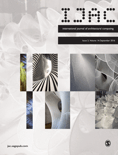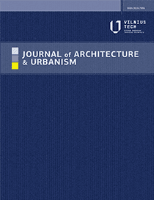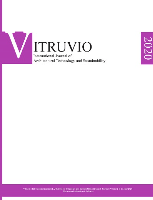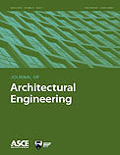
International Journal of Architectural Computing
Scope & Guideline
Advancing Architectural Practices through Cutting-Edge Computing.
Introduction
Aims and Scopes
- Computational Design and Modeling:
The journal explores various computational techniques used in architectural design, including parametric design, generative design, and algorithmic modeling, which help architects create complex forms and optimize design processes. - Integration of Artificial Intelligence:
AI methodologies are frequently discussed, particularly in relation to enhancing creativity in design processes, automating tasks, and improving decision-making through data analysis and machine learning. - Sustainability and Resilience in Architecture:
Research related to sustainable design practices, energy efficiency, and resilience strategies in architecture is a core focus, including the use of technologies like Building Information Modeling (BIM) and generative design for environmental impact assessment. - Collaborative and Community-Driven Design:
The journal emphasizes the role of community involvement in the design process, exploring collaborative approaches that incorporate user-generated content and collective ideation. - Digital Fabrication and Construction Technologies:
Innovations in construction methods, including 3D printing and robotic fabrication, are significant areas of interest, highlighting how technology is reshaping the building process. - Urban Studies and Spatial Analysis:
The journal covers topics related to urban planning and design, including the use of computational tools for analyzing urban morphology, walkability, and spatial dynamics.
Trending and Emerging
- Generative Design and AI Integration:
There is a significant increase in research focusing on generative design approaches and the integration of AI in the design process, emphasizing how technology can enhance creativity and efficiency. - BIM and Digital Twins:
The adoption of Building Information Modeling (BIM) and the concept of digital twins for real-time data integration and management in architecture are trending, highlighting the shift towards data-driven design. - Sustainable and Circular Design Practices:
Emerging themes around sustainability, including circular economy principles and eco-friendly design strategies, are increasingly prominent, showing a commitment to reducing environmental impact. - Interactive and Immersive Technologies:
The use of virtual reality (VR), augmented reality (AR), and mixed reality (MR) in architectural design and education is gaining traction, reflecting a growing interest in immersive experiences. - Community and Participatory Design:
Research on community-driven design processes is on the rise, emphasizing collaborative approaches that involve stakeholders and the public in architectural decision-making.
Declining or Waning
- Traditional Architectural Styles:
Research centered on historical architectural styles and traditional design methods is becoming less frequent, as the focus shifts towards innovative and computational methodologies. - Purely Aesthetic Design Studies:
Papers that focus solely on aesthetic considerations without incorporating computational methods or technological advancements are seeing diminished publication, reflecting a trend towards more integrative and functional approaches. - Basic Visualization Techniques:
There is a noticeable decrease in studies that employ basic visualization techniques in architecture, as more complex and interdisciplinary methodologies gain traction. - Static Design Approaches:
Static or non-interactive design approaches are becoming less relevant in the journal's publications, as dynamic and adaptable designs using computational frameworks are preferred.
Similar Journals

Journal of Architecture and Urbanism
Pioneering Research for Evolving Urban ChallengesThe Journal of Architecture and Urbanism, published by VILNIUS GEDIMINAS TECH UNIV, stands as a pivotal resource for scholars and practitioners in the fields of architecture and urban studies. Since its inception in 2012, the journal has committed to advancing research and discourse on the design, planning, and functionality of urban environments, reflecting a dedicated focus on contemporary challenges in architecture and urbanism. With an impressive open access model implemented since 2018, it ensures that innovative research is accessible to a global audience, fostering collaboration and knowledge exchange. The journal boasts a commendable reputation, categorized in the Q2 quartile for Architecture and Q3 in both Geography, Planning and Development and Urban Studies as of 2023, while maintaining respectable Scopus rankings. Addressing key themes from sustainable design to socio-economic impacts on urban spaces, the journal aims to inspire new models and solutions that meet the evolving needs of growing urban populations. This is a must-read for anyone engaged in the intersection of architecture and urban development.

Architect
Empowering the Next Generation of Architectural ThinkersArchitect is a publication dedicated to the diverse and evolving field of architecture and design, presented by the reputable HANLEY WOOD, LLC. Since its inception in 1975, the journal has traversed critical periods in architecture, offering valuable insights and research that cater to both practitioners and academics alike. The journal holds a Q4 ranking in both Architecture and Visual Arts and Performing Arts, indicating its niche presence within the crowded scholarly landscape. Despite its recent rankings within the Scopus, where it lies in the lower percentiles of the architecture category, the Architect journal provides platforms for innovative discussions and explorations in design, helping to shape the discourse in the architectural community. While the journal is currently accessible via traditional subscription models, it remains a critical resource for those seeking to bridge practice and theory in architecture. As it continues to evolve beyond its historical publication periods, Architect aims to nurture a rich environment for professional growth, scholarship, and dialogue among researchers, designers, and students engaged in the dynamic world of architecture.

VITRUVIO-International Journal of Architectural Technology and Sustainability
Fostering collaboration for a sustainable built environment.Welcome to the VITRUVIO-International Journal of Architectural Technology and Sustainability, a leading open-access journal published by UNIV POLITECNICA VALENCIA, EDITORIAL UPV since 2015 and based in Spain. With its ISSN 2444-9091, this journal is dedicated to advancing the field of architectural technology and sustainability, providing a vital platform for researchers, professionals, and students alike. The journal has made significant strides in the academic landscape, achieving a Q3 ranking in Architecture and a Q4 ranking in Building and Construction for 2023. It features a diverse range of scholarly articles that explore innovative practices, cutting-edge research, and sustainable solutions in architecture. With a Scopus ranking placing it at #70/189 in Architecture and #161/223 in Building and Construction, it is positioned within the 63rd percentile and 28th percentile respectively, demonstrating its increasing impact in these vital fields. We invite you to engage with our content and contribute to the ongoing discourse around sustainability in architectural practice.

Techne-Journal of Technology for Architecture and Environment
Innovating Architecture for Tomorrow's ChallengesTechne - Journal of Technology for Architecture and Environment, published by FIRENZE UNIV PRESS, is an important academic platform that bridges the gap between technology and architecture while addressing the evolving environmental challenges of our time. Established in 2015, this journal provides a forum for innovative research and discussions that critically examine the intersections of architecture, urban studies, and construction engineering. With an impact factor indicative of growing recognition in its field, Techne encompasses a broad spectrum of studies, marking its presence in the Q3 and Q4 quartiles across various categories, including Architecture, Building and Construction, Education, and Health (Social Science). The journal is indexed in Scopus with varying ranks, showcasing its increasing relevance and influence among contemporary literature. Although it operates under a non-open access model, the journal ensures that its scholarly contributions are accessible through institutional connections, making it a vital resource for researchers, professionals, and students seeking to advance their knowledge on the integration of technology in shaping sustainable architectural practices.

METU Journal of the Faculty of Architecture
Inspiring collaboration and creativity in architectural education.METU Journal of the Faculty of Architecture is a reputable academic publication dedicated to advancing research and discourse in the field of architecture. Published by MIDDLE EAST TECHNICAL UNIVERSITY in Turkey, this journal serves as a vital platform for scholars and practitioners, addressing both theoretical and practical topics relevant to contemporary architectural studies. With an impact factor that positions it in the Q3 category for architecture as of 2023, and a Scopus rank of #133 out of 189 in Engineering Architecture, the METU Journal is an influential resource for innovative ideas and studies. Encompassing a wide range of scholarly articles, it fosters academic collaboration between researchers and professionals, making it essential reading for anyone passionate about the evolution of architecture. Though not open access, it provides crucial insights and rigorous research from 2008 up until 2024, contributing significantly to the global discourse on architectural practices and theories.

Journal for Geometry and Graphics
Exploring Innovative Dimensions in Geometry and GraphicsThe Journal for Geometry and Graphics, published by HELDERMANN VERLAG, is a recognized platform dedicated to advancing the fields of geometry and graphics, intersecting with applied mathematics and psychology. With its origins dating back to 1997 and a comprehensive coverage extending up to 2023, the journal provides a critical space for the dissemination of innovative research and theoretical advancements. Although currently positioned in the Q4 quartile across multiple categories, including Applied Mathematics, Applied Psychology, and Geometry and Topology, aspiring authors and researchers are encouraged to submit their works, as the journal plays an essential role in fostering discourse and applications in these disciplines. Moreover, it provides a crucial outlet for interdisciplinary studies that bridge mathematical theory with practical graphical applications. Researchers, professionals, and students alike benefit from the insights and findings published herein, which ultimately contribute to the evolving landscape of geometric thought and graphical representation.

Buildings
Elevating Standards in Architectural and Civil Engineering ResearchBuildings is a premier peer-reviewed journal published by MDPI, focusing on the multidisciplinary aspects of architectural and civil engineering. Established in 2011, this Open Access journal has quickly gained recognition in the academic community and is currently classified in the Q1 category for Architecture and Q2 for Building and Construction, as well as Civil and Structural Engineering, reflecting its significant impact within these fields. With Scopus rankings placing it in the top tier of architecture and construction disciplines, Buildings provides a platform for innovative research and practical applications that push the boundaries of knowledge in building design, sustainability, and infrastructure development. The journal, based in Switzerland and intended for an international audience, welcomes various types of content including research articles, reviews, and case studies, ensuring a comprehensive resource for researchers, professionals, and students alike.

Journal of Architectural Engineering
Building Bridges Between Architecture and EngineeringThe Journal of Architectural Engineering, published by the ASCE (American Society of Civil Engineers), stands as a pivotal resource in the interdisciplinary fields of architecture and engineering. With an ISSN of 1076-0431 and E-ISSN 1943-5568, this journal has garnered a notable reputation since its inception in 1995, currently converging towards 2024. Boasting a Q1 ranking in Architecture and Visual Arts and Performing Arts, alongside respectable Q3 rankings in Building and Construction and Civil and Structural Engineering, the journal places itself in the elite class of scholarly publications, evidenced by its impressive Scopus rankings. Its commitment to providing cutting-edge research ensures comprehensive coverage across various aspects of architectural engineering, facilitating robust interdisciplinary dialogues. Although the journal operates under a traditional access model, its impact on the academic community remains profound, making it an essential platform for researchers, professionals, and students who seek to push the boundaries of knowledge in their respective fields. This journal not only aims to stimulate innovative ideas but also fosters a collaborative environment for advancing sustainable architectural practices in a rapidly evolving built environment.

Journal of Computational Design and Engineering
Elevating Engineering Standards with Cutting-edge ResearchThe Journal of Computational Design and Engineering, published by Oxford University Press, is a premier open-access journal dedicated to advancing the field of computational science, technology, and engineering. With an E-ISSN of 2288-5048 and having transitioned to open access in 2015, this journal fosters a wide-reaching dissemination of high-quality research and innovative methodologies pertinent to computational mathematics, mechanics, modeling, and simulation. Notably recognized within the academic community, the journal boasts impressive rankings, including Q1 in Computational Mechanics and Computer Graphics, underscoring its significance in these fields. With a broad scope that appeals to researchers, professionals, and students alike, the Journal of Computational Design and Engineering plays a vital role in stimulating discussions on the intersection of computation and design, providing a platform for the latest advancements that shape engineering practices globally. As we look forward to its continued publication until 2024, the journal stands as a crucial resource for those aiming to push the boundaries of knowledge in computational engineering disciplines.

Prostor
Shaping the Future of Spatial Studies TogetherProstor is an esteemed scholarly journal published by the University of Zagreb, Faculty of Architecture, dedicated to advancing knowledge in the fields of architecture, urban planning, and spatial studies. Since transitioning to an Open Access model in 2006, Prostor has made significant strides in providing unrestricted access to its contents, fostering a vibrant community of researchers, practitioners, and students interested in contemporary issues surrounding the built environment and social space. The journal's commitment to quality is reflected in its impressive rank within Scopus, particularly in the Arts and Humanities category (64th percentile) and within Engineering (Architecture) at the 49th percentile. Covering a broad array of interdisciplinary topics, Prostor serves as a vital platform for disseminating innovative research and fostering dialogue among professionals while engaging with practical and theoretical explorations of spatial design. With coverage spanning over two decades, Prostor remains a crucial resource for anyone seeking to navigate the complexities of architecture and urban studies.